Plan checklist
Sarie Jenkins
., Black River / Lake Ontario
Planting plan created by Quinte Conservation
Schedule A:
Plants & Property
Land Characteristics
This planting plan is designed based on the land characteristics identified during the day of the site visit. Plants are chosen according to the soil and light conditions on your property. The number of plants chosen for each planting compartment takes into account the square metre area of the space, as well as the amount of current vegetation cover. Your property is part of ecoZone: 6a
Land Characteristics by Compartment
| Length | Width | Area | pH | Soil | Moisture | Light | Height | |
|---|---|---|---|---|---|---|---|---|
| A | 8m | 5m | 40m2 | normal | sandy | dry | full sun | |
| B | 11m | 3m | 33m2 | normal | normal, moist, wet | full sun | ||
| C | 20m | 2m | 40m2 | normal | loamy | normal, moist | full sun | |
| D | 10m | 4m | 40m2 | normal | loamy | normal, moist | full sun | max 1.5m |
| E | 14m | 4m | 56m2 | normal | loamy | normal, moist, wet | full sun | |
| F | 15m | 2m | 30m2 | normal | dry, normal | full sun | ||
| 78m | 3.33m | 239m2 |
Plant Selection Summary
The following shrubs and trees are chosen for their suitability and survivability given the current soil and light conditions in each compartment on your property, as well as preferable features.
| Plant Species | A | B | C | D | E | F | Potted | Bareroot | Wildflower |
|---|---|---|---|---|---|---|---|---|---|
| Buttonbush | 3 | 5 | 8 | ||||||
| Narrow Leaved Meadowsweet | 4 | 5 | 9 | ||||||
| Pasture Rose | 8 | 8 | |||||||
| Highbush Cranberry | 2 | 5 | 4 | 3 | |||||
| Ninebark | 2 | 4 | 6 | 2 | 10 | ||||
| Black Elderberry | 8 | 2 | 6 | ||||||
| Black Chokeberry | 4 | 6 | 10 | ||||||
| Chokecherry | 4 | 4 | |||||||
| Sweet Gale | 2 | 2 | |||||||
| Oswego Tea (Red Bergamot) | 3 | 3 | |||||||
| Boneset | 2 | 2 | |||||||
| Swamp Milkweed | 2 | 2 | |||||||
| Blue Flag Iris | 2 | 2 | |||||||
| Sweet Oxeye | 2 | 3 | 5 | ||||||
| Bush Honeysuckle | 3 | 3 | |||||||
| Swamp Rose | 3 | 3 | |||||||
| Wild Bergamot | 3 | 3 | |||||||
| Allegheny Serviceberry | 4 | 4 | |||||||
| Nannyberry | 6 | 1 | 5 | ||||||
| Yellow Birch | 1 | 1 | 2 | ||||||
| Silver Maple | 1 | 2 | 3 | ||||||
| Red Osier Dogwood | 3 | 15 | 3 | 15 | |||||
| Tamarack | 2 | 2 | |||||||
| Gray Dogwood | 1 | 1 | |||||||
| Subtotal | 15 | 20 | 18 | 21 | 32 | 21 | 40 | 70 | 17 |
| Totals | 127 | ||||||||
Plant Information
The following table summarizes key information about each plant selected for your property.
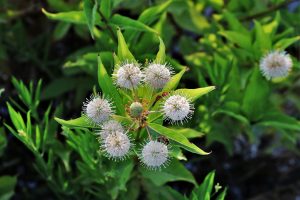
|
ButtonbushHeight: 2 m
Buttonbush is a small to medium-sized deciduous shrub species which typically grows about 2 m in height. This plant may also be known by the common name Button Willow. Twigs are slender to stout and dark red-brown in colour with white speckling. The leaves are bright green coloured, shiny, ovate shaped, oppositely arranged, and have entire margins. The flowers are tiny, tubular, white, fragrant, and appear densely on distinctive, spherical clusters in June. These flowers turn into a dense cluster of seeds, which remain on the plant throughout the winter. The flowers are beneficial for pollinator species, including hummingbirds and butterflies. This is a hardy, adaptable species and an excellent choice for planting on wet shoreline sites.
|
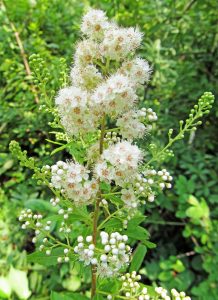
|
Narrow Leaved MeadowsweetHeight: 1-2m
The Narrow Leaved Meadowsweet is an erect, deciduous shrub, which grows in the shape of a mound to a height of 1-2m. This species develops numerous branches and branchlets, giving it a sparse appearance. Leaves produced are simple and narrow with sharply toothed borders growing alternately along the branches. These bright, light green leaves appear crowded, as they grow close together on the stocks and branches. During the fall, leaves turn a yellow-red or yellow-orange colour. Small white to light pink flower clusters appear in the spring growing in a dense, narrow pyramid at the terminal ends of the branches. During late summer to early fall, these flowers produce smooth, papery seed pods.
|
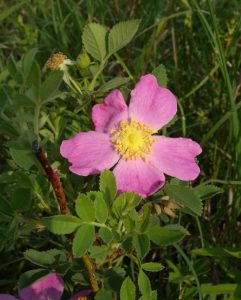
|
Pasture RoseHeight: 1.5 m
The Pasture Rose is a small (1.5m), deciduous shrub which often spreads through suckers to form colonies or thickets in the wild. This species grows erect from a central base with sprawling branches, creating a dense, irregular bush. This shrub produces compound leaves, consisting of 5 to 7 leaflets arranged alternately along the branches. The Pasture Rose yields beautiful 5 centimeter wide white to pink flowers, which bloom in the early summer lasting for approximately a month. The rose hip fruit develops after the flower has died and turns bright red as it ripens. During the fall, the olive green leaves turn yellow to deep red or purple.
|
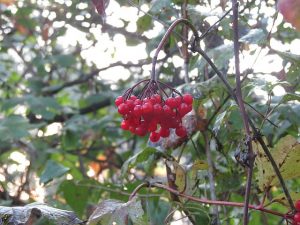
|
Highbush CranberryHeight: 3 m
Highbush Cranberry is a large deciduous shrub species that typically grows about 3 m in height. The branches on this shrub are dense with arching stems, creating a full form. The leaves are oppositely arranged, Maple leaf shaped, have 3 lobes, and have entire or toothed margins. The flowers are showy, creamy white coloured, appear in flat clusters with larger florets surrounding smaller ones, and bloom between May and June. These flowers change into drooping, bright red berry clusters that persist throughout the winter. While the berries are edible to humans, they are very tart when consumed raw so are typically cooked first. This shrub has very attractive fall foliage, changing a reddish purple colour. The flowers are beneficial to pollinator species, like bees and butterflies. The fruit is beneficial to wildlife species, including birds and small mammals. The root system is extensive, making this shrub valuable for controlling erosion and stabilizing loose soil. This species can be found across Canada from Newfoundland to British Columbia, but is most commonly found in Ontario and Quebec.
|
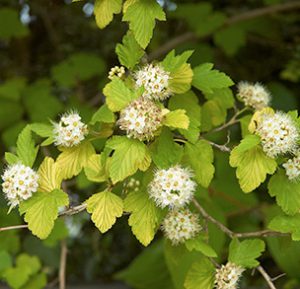
|
NinebarkHeight: 2-3m
The Common Ninebark is a very hardy, large (2-3m in height), deciduous shrub naturally occurring within riparian zones. This species is often planted as an ornamental shrub for its exfoliating bark which reveals reddish-light brown inner bark. This shrub is multi-stemmed with numerous horizontal and ascending branches creating a full, round shape. The Common Ninebark produces dull green, ovate to round shaped leaves with three to five lobes per leaf. During the fall the leaves turn brilliant yellow or dark purple. Between May and June, showy, bell-shaped flowers bloom in clusters on the terminal ends of the branches. During the summer, these flowers give way to small green or green-yellow berries which turn a bright red upon ripening.
|
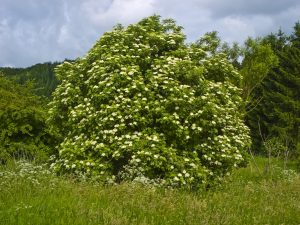
|
Black ElderberryHeight: 4 m
The Black Elderberry is a large, fast-growing, deciduous shrub or small tree, which typically grows to 4m. This species tolerates a variety of conditions and is commonly found in sunny locations with well-drained soils. Black Elderberry can be single or multi-stalked with numerous branches creating a full, round body. Leaves are compound, with 5-7 leaflets that grow opposite each other along the branch. During the fall, leaves tend to turn a pale yellow. During late May to early June, this species produces flowers that are ivory white and grow in flat topped clusters. By late August, flowers turn to glossy, deep purple fruit, which attract a variety of wildlife like songbirds and small mammals. Ripe fruit is edible for humans and is commonly made into jams and jellies. The root system of this species is shallow, and can form colonies through suckering.
|
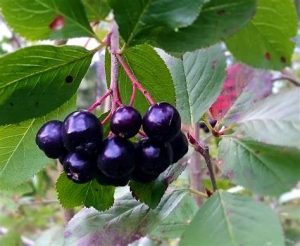
|
Black ChokeberryHeight: 1-3m
The Black Chokeberry is a medium sized deciduous shrub that typically grows between 1-3m with edible fruit. This species requires full sun to partial shade and can tolerate soil conditions from loamy and moist to rocky and dry. Naturally, Black Chokeberry is found in wet wooded areas such as; swamps, along shorelines, and within forest understory. This species is multi-stemmed, and forms thickets from stems which arise from the roots. Leaves are simple, growing alternately along the branch turning a bold red to orange during the fall. During spring, clusters of showy, white flowers appear turning into dark purple berries by fall. This species is resistant to drought, insects, pollution, and disease. The Black Chokeberry is often cultivated as an ornamental plant and food product. Additionally, this species is useful for bank stabilization and erosion control applications.
|
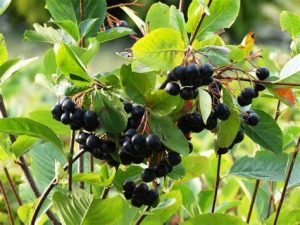
|
ChokecherryHeight: 6-9 m
The Chokecherry is a large deciduous shrub or small tree which grows between 6 and 9 m tall and is a member of the Rose family. It produces a twisted or crooked trunk as well as a narrow, oval to round crown composed of many slender branches. Leaves are alternately arranged, simple, have a deep green upper surface, and light matte green undersides with tufts of hair at the vein axils. During the fall, foliage turns a vibrant deep red to fire yellow or orange. Between May and June, small showy white flowers grow in cylindrical clusters on the terminal ends of branches. By mid-August, flowers turn into shiny deep red or black cherries, which hang in elongated clusters. The fruit is ripe by September and provides a food source for birds and small mammals. The Chokecherry is often found as pure stands forming thickets, or mixed with other early succession shrub and tree species. This fast-growing plant can quickly invade logged land, abandoned farms, and exposed shorelines. The fibrous and wide-spreading root system of this shrub make it an ideal plant for erosion control and bank stabilization. This species possesses the ability to withstand moderate flooding and drought.
|
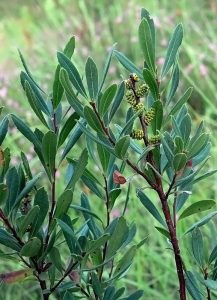
|
Sweet GaleHeight: 1-2m
Sweet Gale is a medium-sized shrub which grows into a thick bush about 1-2 m tall. This species produces 1-8 cm long, oblong-lanceolate leaves which are finely toothed at the tip and are spirally arranged. When bruised, these leaves give off a pleasant aroma. Male and female catkins are produced on separate plants. The seeds are dispersed from the female plants via water, as they float on two corky bracts. This shrub also provides a good food source for bird species that eat the seeds including Grouse, Chickadees, and Bluebirds. Mammal species like Beavers and White-Tailed Deer also browse on the twigs and leaves of this plant.
|
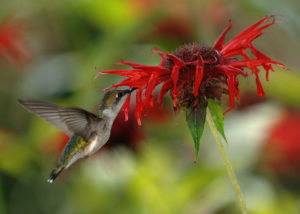
|
Oswego Tea (Red Bergamot)Height: 50 cm
Oswego Tea is a showy perennial wildflower species that typically grows about 50 cm in height. This plant may also be known by the common names Red Bergamot or Scarlet Beebalm. The leaves are dark green, oval shaped, have a minty fragrance. The unique flowers are bright red and grow in dense rounded clusters, with individual tubular flowers that bloom between May and October. The beautiful flowers of Oswego Tea attract various pollinator species like hummingbirds, butterflies, and bees. The Oswego Tea plant is susceptible to a common fungal disease, called powdery mildew, when planted in dry soils. Historically, the leaves of the plant have been used for antiseptic purposes, as well as poultices to heal minor wounds and skin infections.
|
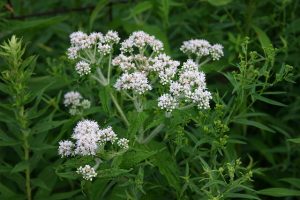
|
BonesetHeight: 1.5 m
Common Boneset is a wildflower species that can grow up to 1.5 m in height. This plant may also be known by the common name Thoroughwort. The leaves are oppositely arranged, dark green coloured, lanceolate shaped, wrinkly, have long narrow tips, serrated margins, and distinctively unite through the plant’s hairy stem. The flowers are tiny, white coloured, appear in flat-topped clusters, and bloom between July and September. The flowers are beneficial to pollinator species, like bees and butterflies. All parts of the plant are toxic. This wildflower spreads well and can be used to naturalize un-vegetated areas.
|
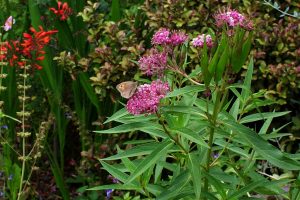
|
Swamp MilkweedHeight: 1 m
Swamp Milkweed is a beautiful wildflower species that typically grows about 1 m tall. The leaves are light green coloured, narrow, lance shaped, and oppositely arranged. The flowers are showy, fragrant, bright pink, appear in clusters on flowering stems, and bloom between July and August. The flowers give way to large, long and narrow, brown seed pods, which produce an abundance of seeds with tufts of long, white hairs. The flowers are beneficial to pollinator species, like bees and butterflies. As with all Milkweeds, the stem exudes a milky sap when broken, however the sap of the Swamp Milkweed is less milky than other species. This sap is critical for caterpillars of the endangered Monarch Butterfly to deter predators.
|
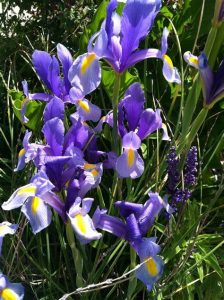
|
Blue Flag IrisHeight: 0.5 m
The Blue Flag Iris is a showy perennial wildflower that typically grows about 0.5 m in height. This plant may also be known by the common name Harlequin Blue Flag. The leaves are light green, sword-shaped, slightly arched or erect, and appear growing out as a cluster around the base of the plant. The attractive blue flowers start to bloom in the early spring, emerging from a tall flowering stalk that can reach up to 1 m. The flowers are beneficial to pollinator species, like bees and butterflies. The seeds are also beneficial to wildlife species, like birds and small mammals.
|
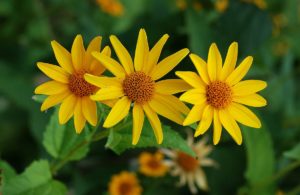
|
Sweet OxeyeHeight: 2m
Sweet Oxeye, also known as False Sunflower, is an attractive, herbaceous, perennial wildflower, which can grow to almost 2 m tall. The flowers are perched atop a stiff stem, with a brownish-yellow center cone surrounded by bright yellow to orange rays. Leaves are 5-12 cm long and 2-8 cm wide, oppositely arranged along the stem, ovate to lanceolate in shape, and have a toothed margin. This wildflower grows best in moist, well-drained soils, preferring full sun, but will tolerate partial shade. Some common natural habitats for the Sweet Oxeye are prairies, meadows, forest edges, and stream banks. Sweet Oxeye is drought tolerant so could be planted in difficult dry sites, but will grow best with regular watering. A large variety of insect species are attracted to the Sweet Oxeye, making it a great addition to a habitat garden.
|
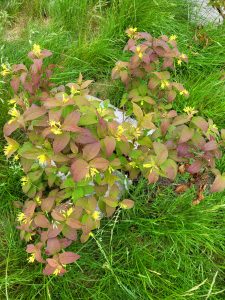
|
Bush HoneysuckleHeight: 1m
The Bush Honeysuckle is a small, hardy, deciduous shrub that rarely grows taller than 1 m in height. The leaves are simple, oppositely arranged, ovate shaped, and have finely toothed margins. During the spring and summer, the leaves are dark green in colour, then in the fall they take on a variety of colours ranging from a deep purple to light yellow. The flowers are small, showy, yellow to orange colored, trumpet shaped, appear in clusters on the tips of branches, and bloom between June and July. The flowers are beneficial to pollinator species, including hummingbirds and butterflies. The roots of the Bush Honeysuckle are fibrous, giving it the ability to form thickets and making it an ideal shrub to plant for erosion control.
|
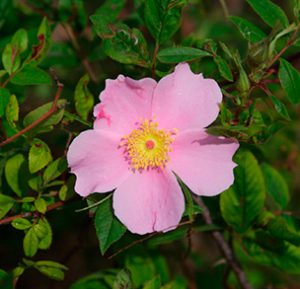
|
Swamp RoseHeight: 2m
The Swamp Rose is a beautiful perennial shrub species that typically grows 2m in height and spreads 2m. It is visually appealing with large pink flowers that last about 6-8 weeks. These flowers have five pink petals, a yellow center, and a pleasant fragrance. This species produces oblong shaped, compound leaves comprised of seven leaflets with serrated edges. The Swamp Rose produces red, round, fleshy fruit called rose hips, which remain on the bush throughout winter. These fruiting bodies provide a winter food source for wildlife, such as Grouse, Black Bears, Deer, and Rabbits. Swamp Rose may be confused with Prickly Wild Rose, which has a similar appearance. However, Swamp Rose can easily be distinguished by the presence of curved thorns, which appear at the nodes of the twigs without any occurring between the nodes. Swamp Rose grows best in moist, rich soils such as swamps and marshy shorelines. However, this species can also tolerate drier, loamy soils.
|
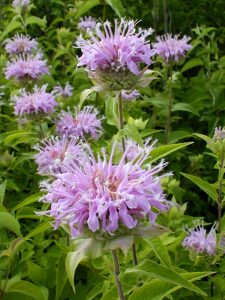
|
Wild BergamotHeight: 1 m
Wild Bergamot is a perennial wildflower species that is member of the mint family and can grow about 1 m tall. Its stems are light green and smooth with abundant branching on the upper half. The leaves are oppositely arranged, broadly lanceolate shaped, 6-10 cm long, and have toothed edges. The also leaves emit a aromatic minty/oregano scent when crushed. The flowers are showy, pink/lavender coloured, appear on the ends of flowering stems, and bloom between July and September. The flowers bloom in the center of the head first, moving outwards creating a wreath. The flowers are beneficial to pollinator species, like bees and butterflies. This wildflower spreads well and can be used to naturalize un-vegetated areas. The roots can be useful for controlling erosion and stabilizing shorelines.
|
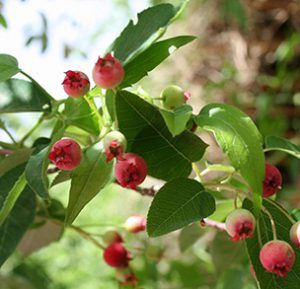
|
Allegheny ServiceberryHeight: 3-10 m
The Allegheny Serviceberry is an attractive deciduous shrub species that can reach about 3 m as a shrub or up to 10 m as a tree. This plant may also be known by the common name Smooth Serviceberry. It can be grown either in the form of a single stem tree or multi-stemmed shrub comprised of two or three smaller trunks. The leaves are dark green, alternately arranged, oval shaped, and have finely toothed margins. The flowers are showy, fragrant, have 5 petals, appear in drooping clusters, and bloom in April before the leaves emerge. The flowers produce small reddish purple to black berries, which are edible and flavorful to humans. The fruit is beneficial to wildlife species, including birds and small mammals. The root system is valuable for controlling erosion and stabilizing loose soil. This plant is often used for ornamental purposes as a small tree in urban areas.
|
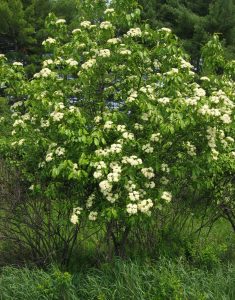
|
NannyberryHeight: 3 m
Nannyberry is a large deciduous shrub species that typically grows about 3 m in height. The leaves are dark green, ovate shaped, oppositely arranged, have a pointed tip, and have finely toothed margins. The flowers are showy, white colored, appear in flat topped clusters, and bloom in May. These flowers produce blueish black berries, which are edible to humans and persist throughout the winter. The flowers are beneficial to pollinator species , like bees and butteries. The fruit is beneficial to wildlife species, including birds and small mammals. This shrub has attractive fall foliage. The root system is extensive, making this plant valuable for controlling erosion and stabilizing loose soil. This shrub can be pruned to have a single stem and grown as a small tree instead of a shrub.
|
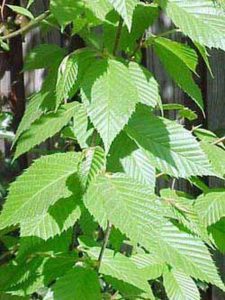
|
Yellow BirchHeight: 25 m
Yellow Birch is a native deciduous tree species that can grow up to 25 m in height. The bark is thin, flaky, shiny, and can be brownish-yellow, bronze, or silvery colored. The leaves are deep greenish-yellow, simple, alternately arranged, oval shaped, have doubly serrated edges, and are about 8-11 cm long. This tree species produces catkins in April-May, which are slim, cylinder shaped, yellowish brown flower clusters. In the Fall, seed pods are produced that are brown colored, cone shaped, and break apart easily. Yellow Birch is a slow growing tree but can live up to 150 years. This tree species is beneficial to wildlife species like birds and mammals.
|
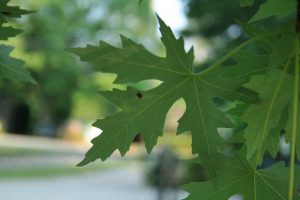
|
Silver MapleHeight: 30m
The Silver Maple is a fast growing, deciduous Maple tree famous for its majestic, mature form. This species has a broad, round crown that sits on top of a tall straight trunk reaching 30m in height. Its ascending branches give this tree a full, bushy appearance. Silver Maple leaves can be differentiated from other Maple leaves due to the deep notches on their lobes. It has a silvery white colour on its underside in contrast to bright, light green topside. During the fall, the leaves on the Silver Maple turn a reddish orange to bright golden yellow. Between late April and May, inconspicuous, small greenish red flowers bloom and by June turn to yellowish-green or brownish pairs of winged keys. The Silver Maple's shallow, spreading root system and ability to withstand flood and drought make it an excellent tree to utilize for erosion control and shoreline stabilization.
|
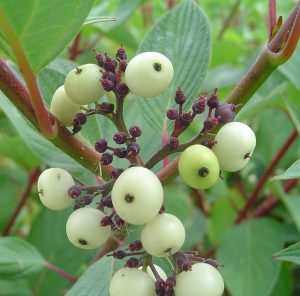
|
Red Osier DogwoodHeight: 1.5-4m
The Red Osier Dogwood is a medium-sized, deciduous shrub native throughout Northern and Western North America which typically grows to 1.5-4m. This species is multi-stemmed with numerous erect and ascending bright red branches that create a loose and spreading form. Leaves produced are simple, two-toned with a dark green upper side and light green underside. They are arranged opposite each other along the branches. During the fall, the foliage turns a brilliant red to dark purple. Clusters of small, creamy white flowers form on the terminal ends of the branches between June and July. The Red Osier Dogwood produces blueish-white fruiting bodies during late summer, which may persist throughout the winter. This shrub's berries provide an important winter food source for numerous species, from large deer to small wintering birds.
|
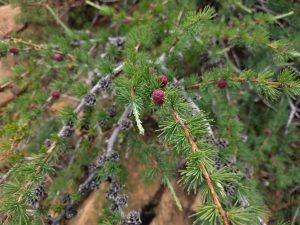
|
TamarackHeight: 20 m
Tamarack is a small to medium sized, deciduous coniferous tree species that grows up to 20 m tall. This plant may also be known by the common name American Larch. The bark is scaly and reddish brown coloured. The needles are delicate, 2-4 cm long, blueish-green coloured, grow in clusters of 15 to 25, and change golden yellow in the fall. This tree provides food and habitat for wildlife species, including birds and mammals. Tamarack is a fast-growing, long lived species that can live up to 150 years and is found across all of Canada. The wood from this tree is decay-resistant and has been used to make railway ties, posts, and crates. Tamarack is considered unique because it is the only conifer species to drop its needles in the fall.
|
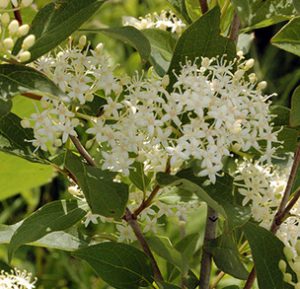
|
Gray DogwoodHeight: 2-3m
The Gray Dogwood, also referred to as Northern Swamp Dogwood or Panicle Dogwood, is a medium-sized, deciduous shrub which typically grows 2-3m. This species is multi-stemmed, with a full, round form. The leaves are green and arranged alternately along the branches. During the fall, leaves turn a bright red to deep purple colour. Between May and June, showy clusters of small white flowers bloom. These flowers turn into white fleshy berries late in the summer. The reddish-pink stems hold the berries throughout the winter, creating an artful contrast to the gray bark and snowy scenery. The Gray Dogwood is tolerant of a variety of environmental conditions and its complex, fibrous root system make it an ideal plant to use for controlling erosion.
|
Compartment A
Naturalization Area
Low and flowering. pH: normal
pH: normal Depth: bareroot
Depth: bareroot-
 Moisture: dry
Moisture: dry -
 Soil Type: sandy
Soil Type: sandy -
 Light conditions: full sun
Light conditions: full sun
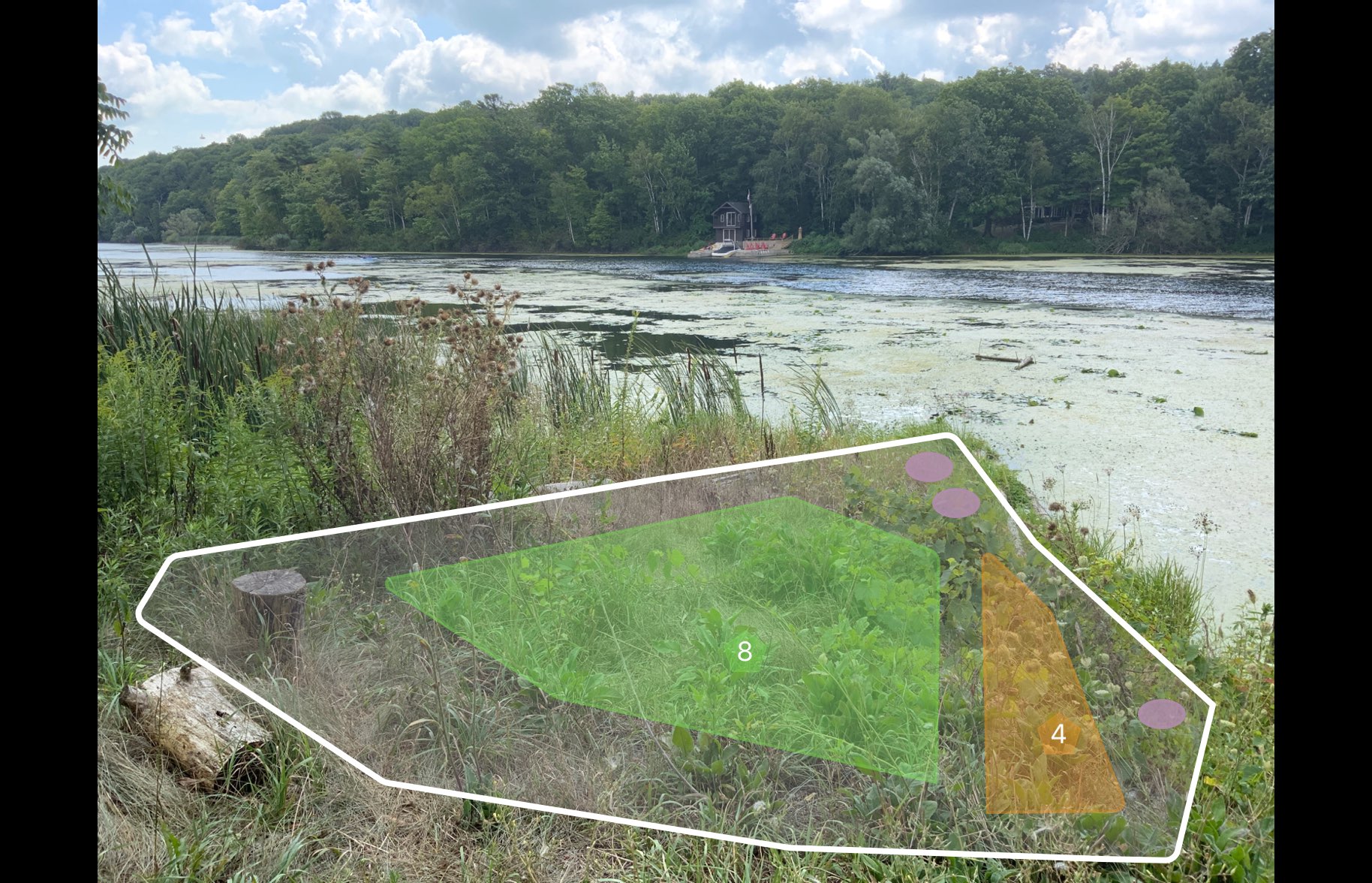
Compartment B
Naturalization Area
Berry producing shrubs. pH: normal
pH: normal-
 Moisture: normal, moist, wet
Moisture: normal, moist, wet -
 Light conditions: full sun
Light conditions: full sun
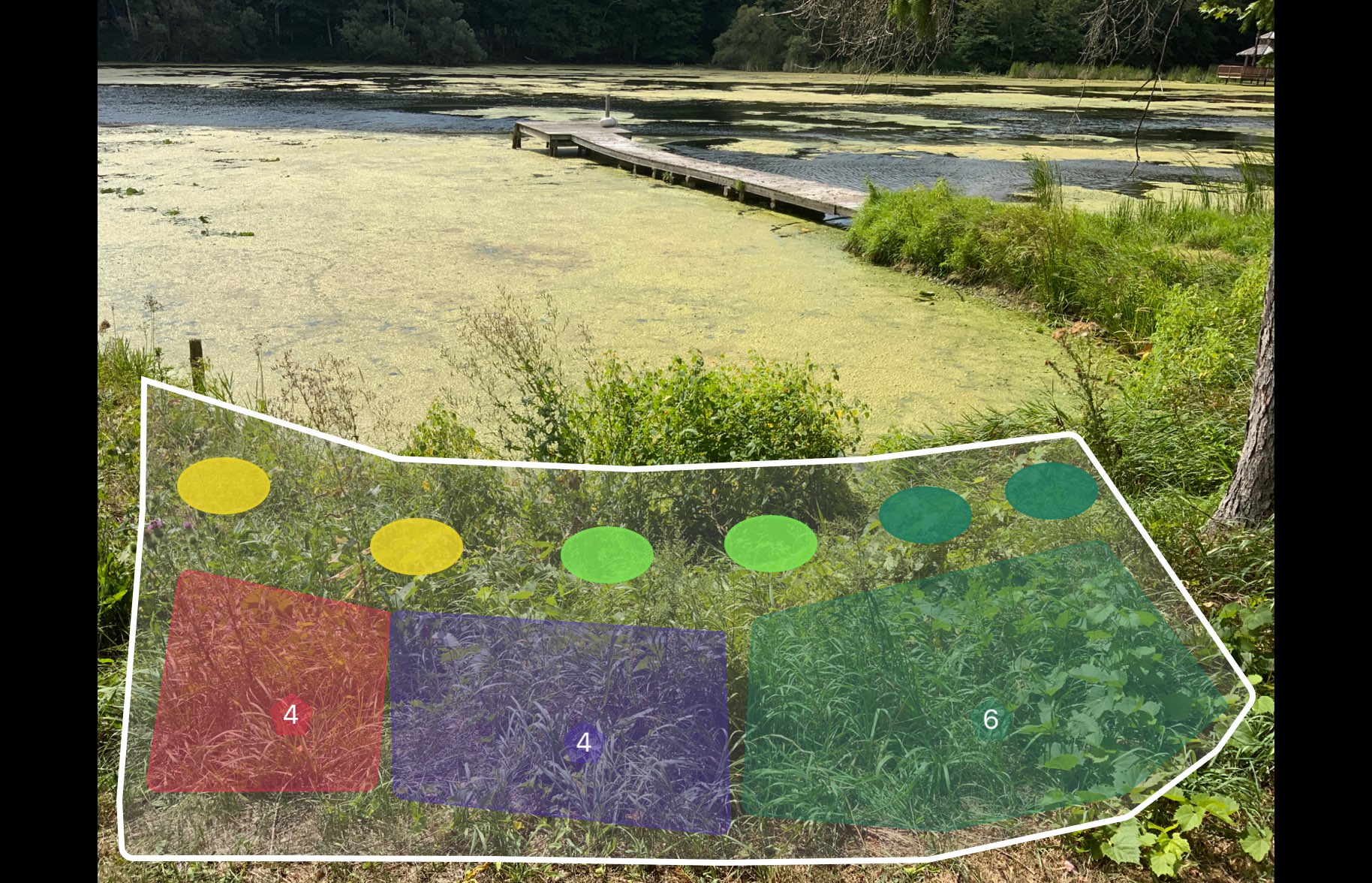
Compartment C
Naturalization Area
Wildflowers and low shrubs pH: normal
pH: normal-
 Moisture: normal, moist
Moisture: normal, moist -
 Soil Type: loamy
Soil Type: loamy -
 Light conditions: full sun
Light conditions: full sun
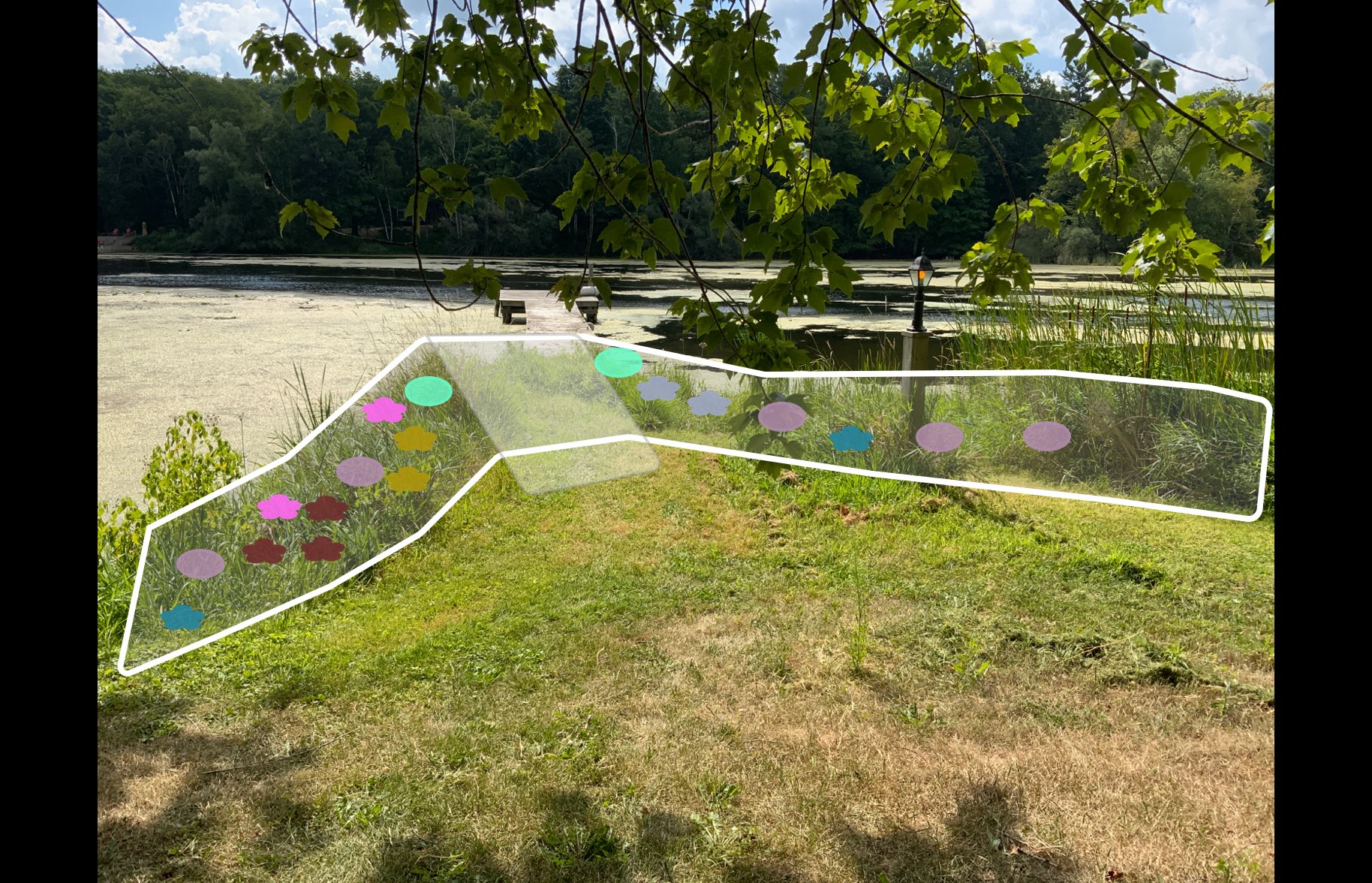
Compartment D
Naturalization Area
Low flowering with wildflowers pH: normal
pH: normal-
 Moisture: normal, moist
Moisture: normal, moist -
 Soil Type: loamy
Soil Type: loamy  Plant Height: max 1.5m
Plant Height: max 1.5m-
 Light conditions: full sun
Light conditions: full sun
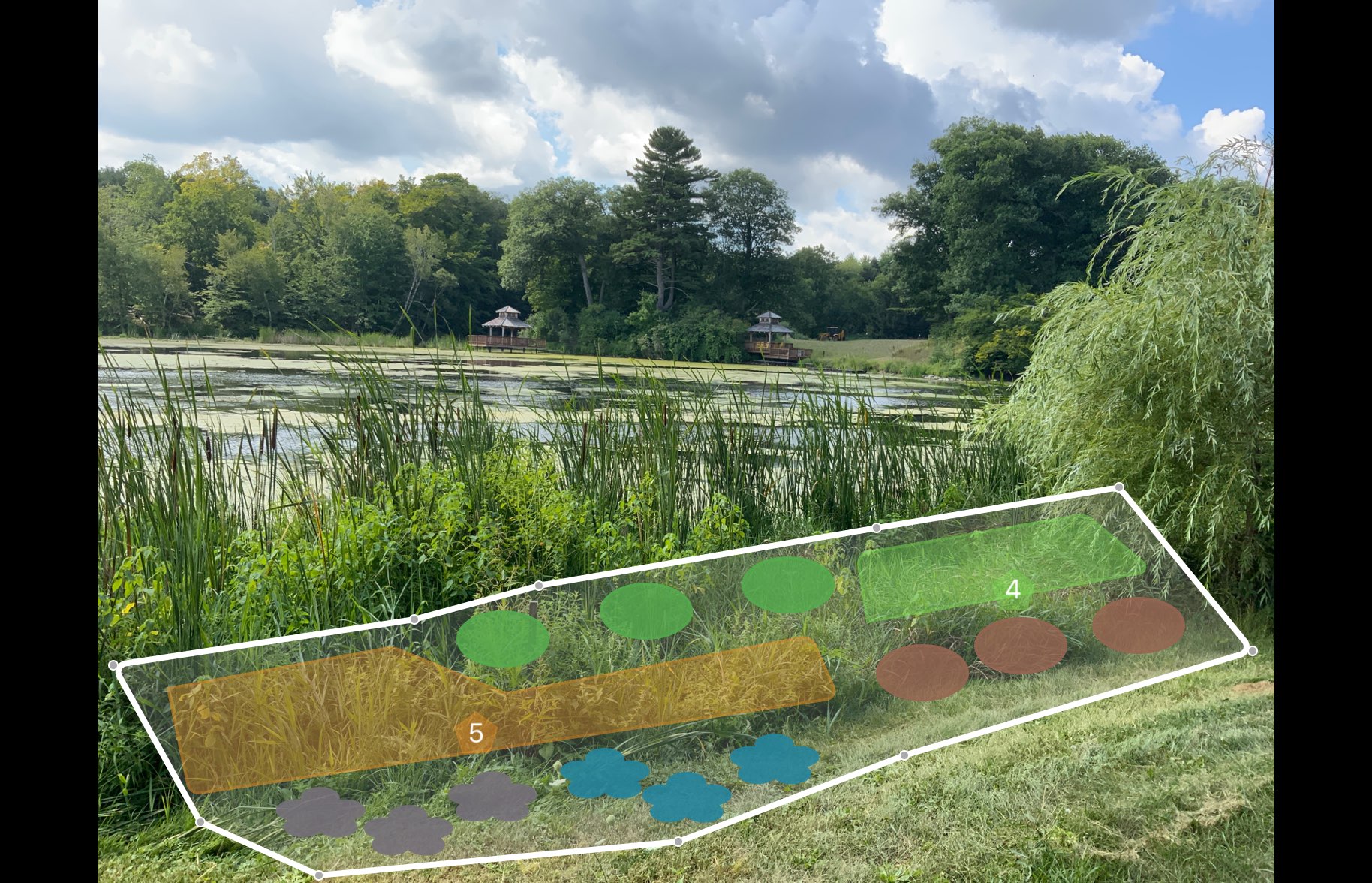
Compartment E
Naturalization Area
Higher berry producing shrubs with several trees. pH: normal
pH: normal-
 Moisture: normal, moist, wet
Moisture: normal, moist, wet -
 Soil Type: loamy
Soil Type: loamy -
 Light conditions: full sun
Light conditions: full sun
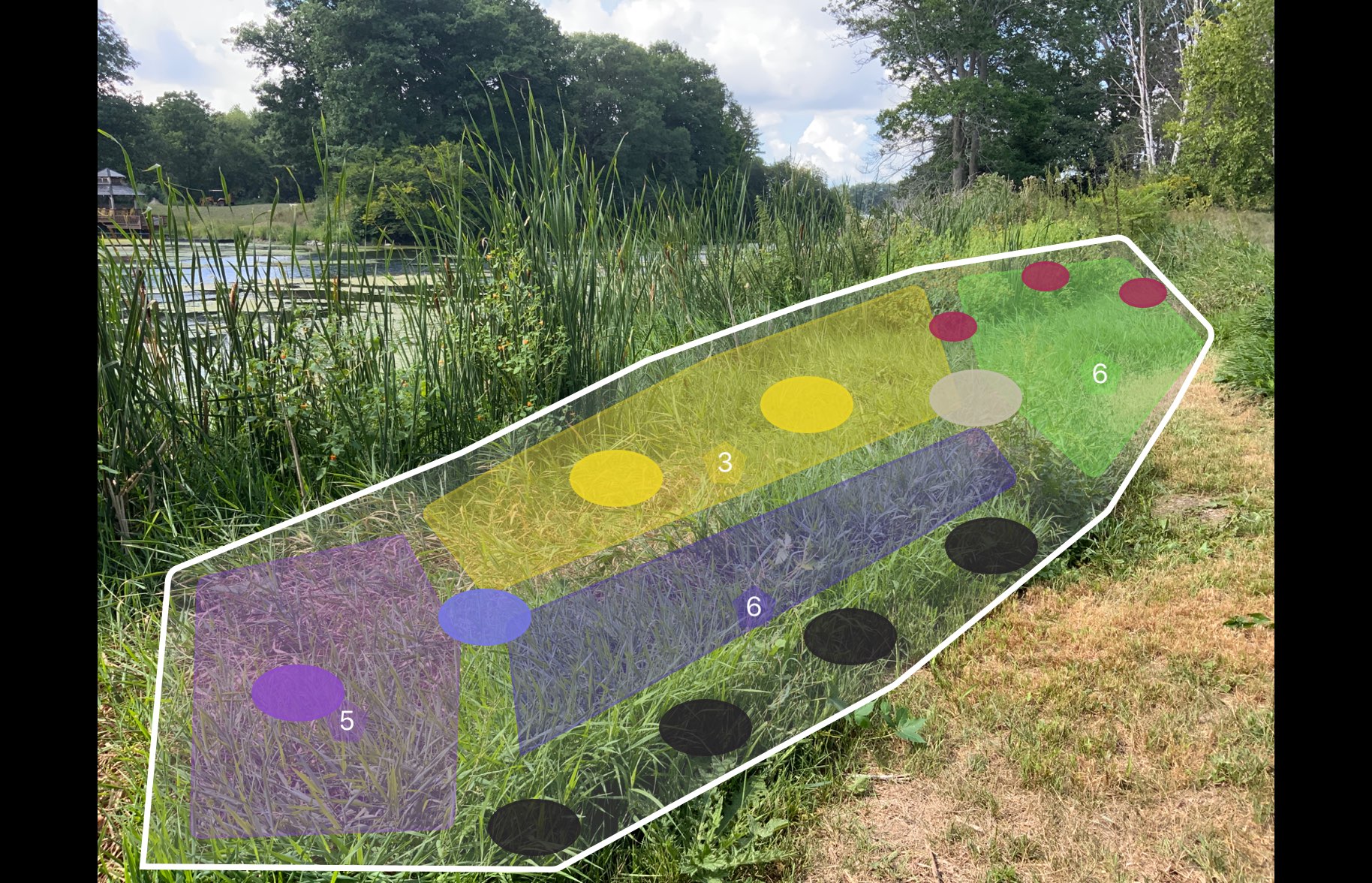
Compartment F
Naturalization Area
Trees and shrubs. pH: normal
pH: normal-
 Moisture: dry, normal
Moisture: dry, normal -
 Light conditions: full sun
Light conditions: full sun
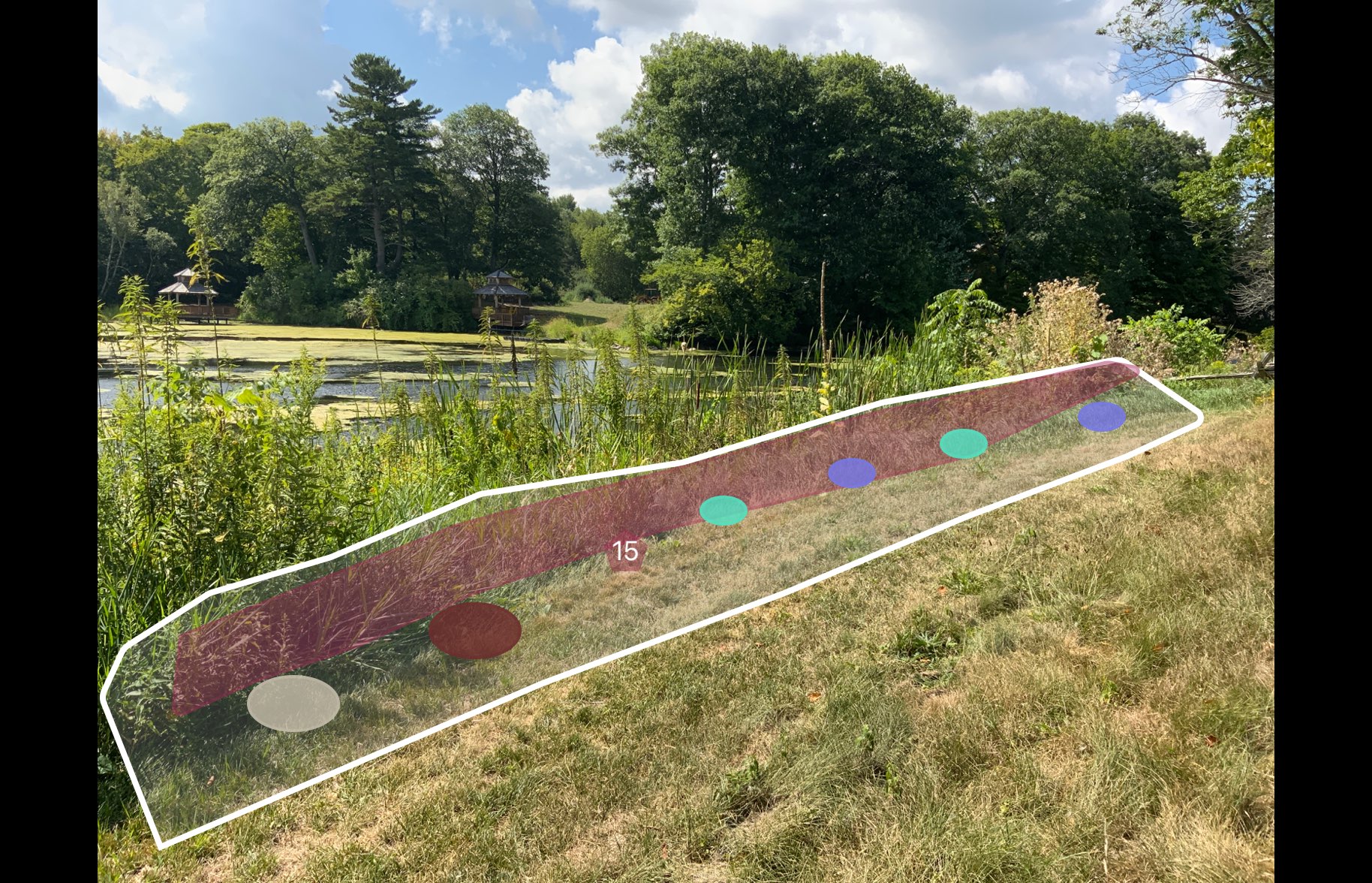
Schedule B
Financial Summary
Project by: Quinte Conservation
The following section outlines the total cost of your project. It has been divided into 2 sections; 1- Plants and Material, 2- Services. It also includes the breakdown of the landowner contribution and the portion that will be paid by Watersheds Canada, as outlined in the Project Costs Total table.
The Natural Edge program has received generous funding to help support the costs of plants, materials, and project coordination and delivery, making this program possible.
Potted stock |
|||
| Item | Quantity | Cost/Item | Subtotal |
|---|---|---|---|
| Buttonbush | 8 | 15.45 | 123.60 |
| Highbush Cranberry | 4 | 15.45 | 61.80 |
| Ninebark | 2 | 15.45 | 30.90 |
| Black Elderberry | 2 | 15.45 | 30.90 |
| Sweet Gale | 2 | 15.45 | 30.90 |
| Bush Honeysuckle | 3 | 15.45 | 46.35 |
| Swamp Rose | 3 | 15.45 | 46.35 |
| Allegheny Serviceberry | 4 | 15.45 | 61.80 |
| Nannyberry | 1 | 15.45 | 15.45 |
| Yellow Birch | 2 | 15.45 | 30.90 |
| Silver Maple | 3 | 15.45 | 46.35 |
| Red Osier Dogwood | 3 | 15.45 | 46.35 |
| Tamarack | 2 | 15.45 | 30.90 |
| Gray Dogwood | 1 | 15.45 | 15.45 |
| Total Potted plant stock | 40 | 618.00 | |
Bareroot stock |
|||
| Item | Quantity | Cost/Item | Subtotal |
| Narrow Leaved Meadowsweet | 9 | 2.58 | 23.22 |
| Pasture Rose | 8 | 2.58 | 20.64 |
| Highbush Cranberry | 3 | 2.58 | 7.74 |
| Ninebark | 10 | 2.58 | 25.80 |
| Black Elderberry | 6 | 2.58 | 15.48 |
| Black Chokeberry | 10 | 2.58 | 25.80 |
| Chokecherry | 4 | 2.58 | 10.32 |
| Nannyberry | 5 | 2.58 | 12.90 |
| Red Osier Dogwood | 15 | 2.58 | 38.70 |
| Total Bareroot plant stock | 70 | 180.60 | |
Wildflower stock |
|||
| Item | Quantity | Cost/Item | Subtotal |
| Oswego Tea (Red Bergamot) | 3 | 5.15 | 15.45 |
| Boneset | 2 | 5.15 | 10.30 |
| Swamp Milkweed | 2 | 5.15 | 10.30 |
| Blue Flag Iris | 2 | 5.15 | 10.30 |
| Sweet Oxeye | 5 | 5.15 | 25.75 |
| Wild Bergamot | 3 | 5.15 | 15.45 |
| Total Wildflowers plant stock | 17 | 87.55 |
Tending materials |
|||
| Item | Quantity | Cost/Item | Subtotal |
|---|---|---|---|
| Mulch | 127 | 1.55 | 196.85 |
| Tree guards (deciduous only) | 5 | 1.50 | 7.50 |
| Total Tending materials | 204.35 |
Totals
| 1-Plants and materials | |
|---|---|
| Bareroot plant stock | 180.60 |
| Potted plant stock | 618.00 |
| Wildflower plant stock | 87.55 |
| Tending materials | 204.35 |
| Plants & Materials | 1090.50 |
| 2-Services | Quantity | Cost/Item | Subtotal |
|---|---|---|---|
| Quinte Conservation's Site visit (Site visit in-kind) | 1 on 08/25/2020 | 0.00 | 0.00 |
| Plant stocking | 127 | 2.00 | 254.00 |
| Mulching & tree guard installation | 127 | 1.50 | 190.50 |
| Shipping & handling of materials | 250.00 | ||
| Planting plan | 250.00 | ||
| Project management and delivery | 400.00 | ||
| Administration fee | 50.00 | ||
| Services total | 1394.50 |
| Total Project Costs | Subtotal |
|---|---|
| Total project value (including in kind contributions) | 2485.00 |
| Total eligible costs (excluding in kind contributions) | 2485.00 |
| Quinte Conservation's contribution (100% of eligible costs) | 2485.00 |
| Landowner contribution (0% of eligible costs) | 0.00 |
Schedule C
Project Agreement
Stewardship Agreement
Please indicate your agreement to this proposed plan by signing the following Stewardship Agreement and submitting it, along with your financial contribution, to:
Quinte Conservation
2061 Old Highway #2
RR#2, Belleville, Ontario
K8N4Z2
Plant Availability
Please note that plant species may need to be changed based on plant stock availability at the time of ordering.
Project Completion
Upon receiving your signed stewardship agreement and financial contribution, a date will be booked to complete the project. Watersheds Canada will supply all plants, materials, and planting labour. If there are particular dates that you would prefer, we will do our best to accommodate your requests.
The Natural Edge Stewardship Agreement with Quinte Conservation
Agreement made this 10th Day of the Month of September in the Year 2020.
BETWEEN Sarie Jenkins . . Ontario (Hereinafter called the OWNERS)
AND Quinte Conservation 2061 Old Highway #2 RR#2, Belleville, Ontario K8N4Z2 (Hereinafter called QC)
WHEREAS the Owners and QC have met and discussed plans for shoreline naturalization on the specified area(s) in Schedule A existing on the Owners’ land;
WHEREAS the Owners indicate approval of the project as proposed; and
WHEREAS the project is, or will be for the benefit of the Owners and others;
NOW THEREFORE THE PARTIES AGREE AS FOLLOWS:
1. This Agreement shall be in effect for a period of 5 years, commencing with the date of this Agreement.
2. The Owners and QC agree that the areas where the work is to be performed is as described in Schedule A.
3. The Owners grant QC, its contractors, employees and agents, the right to enter the property to perform the work agreed upon as outlined in Schedule A. In addition, QC, its contractors, employees and agents may inspect the work performed for the purposes of monitoring the project and survival assessment, with prior agreement with Owners for date and time of inspection.
4. The Owners agree to contribute the “Landowner contribution (0% of eligible costs)” and pay the costs indicated in Schedule B.
5. In instances where the Owners are to pay QC for work to be performed (outlined in Schedule A), the Owners agree to provide payments to QC prior to the commencement of that operation. Failure of payment shall constitute a breach of this Agreement and the Owners agree this Agreement will be terminated and thereupon the Owners agree to pay QC the estimated costs of the operations of the project completed, if any.
6. The Owners agree, if necessary, to perform a reasonable amount of maintenance, which is described in the Native Plant Care Guide, available at watersheds.ca.
7. If the contractor is required to perform the work outlined in Schedule A, then the contractor carrying out the work on the land described will be required to take out and furnish evidence of a comprehensive policy of public liability and property damage coverage. The contractor and their workers will be required to be in good standing with the Workplace Safety and Insurance Board prior to performing the work.
8. The Owners agree not to remove, destroy or alter the project without prior consultation and approval of QC. Pruning and trimming planted nursery stock, or adding replacement native nursery stock is exempt.
9. The Owners agree not to mow the planted area.
10. The Owners do acknowledge that QC, its contractors, employees and agents, having performed said works, are not under further obligation with respect to survival of nursery stock, inspection, or maintenance.
11. The Owners, in the absence of negligence, hereby remises, releases and forever discharges QC, its contractors, employees and agents from all claims and demands for injuries, including death, loss, damages and costs in any way related to or connected with installation and maintenance of the work described or resulting from any deleterious effects of the work to the land or to the lands and buildings thereon retained by the Owners.
IN WITNESS WHEREOF the parties have agreed to the contents of this plan; SIGNED:
About this program
About Quinte Conservation
Quinte Conservation is a community based environmental protection agency that serves 18 municipalities in the watersheds of the Moira, Napanee and Salmon Rivers and Prince Edward County. Our programs, services and working alongside residents create a sustainable ecosystem where people and nature live in harmony.
This program was created by Watersheds Canada
We believe that every person has the right to access clean and healthy lakes and rivers in Canada. At Watersheds Canada, we work to keep these precious places naturally clean and healthy for people and wildlife to continue using for years to come. We love working with others to meet the needs of local communities, whether you’re a concerned citizen, a landowner, a lake association looking for help, or a coalition of groups interested in activating your local community.

